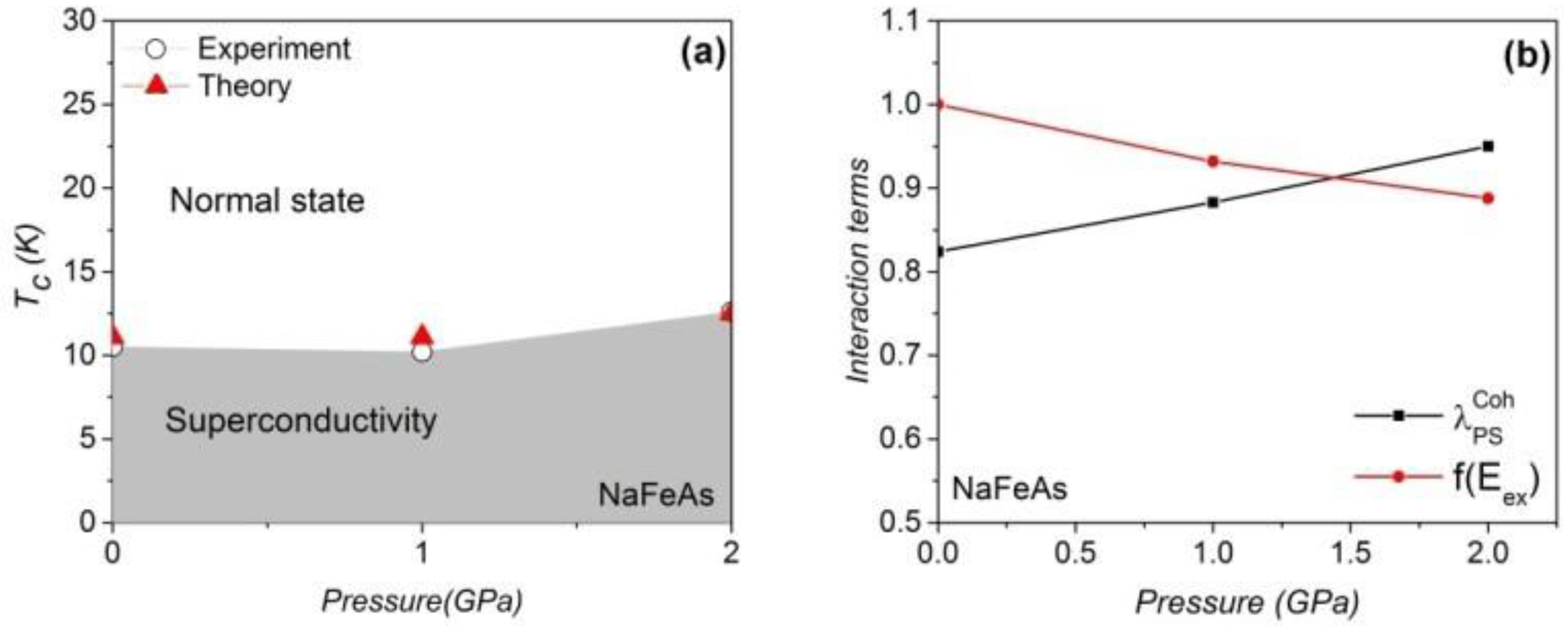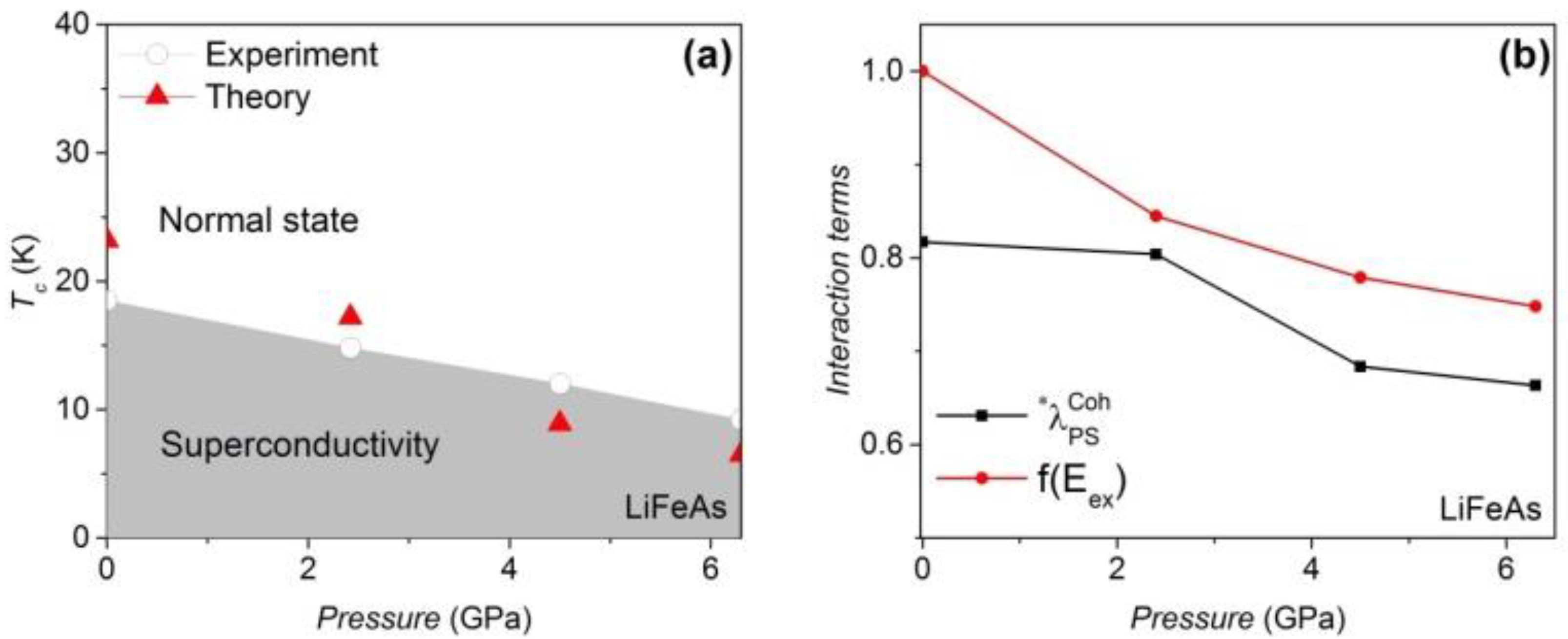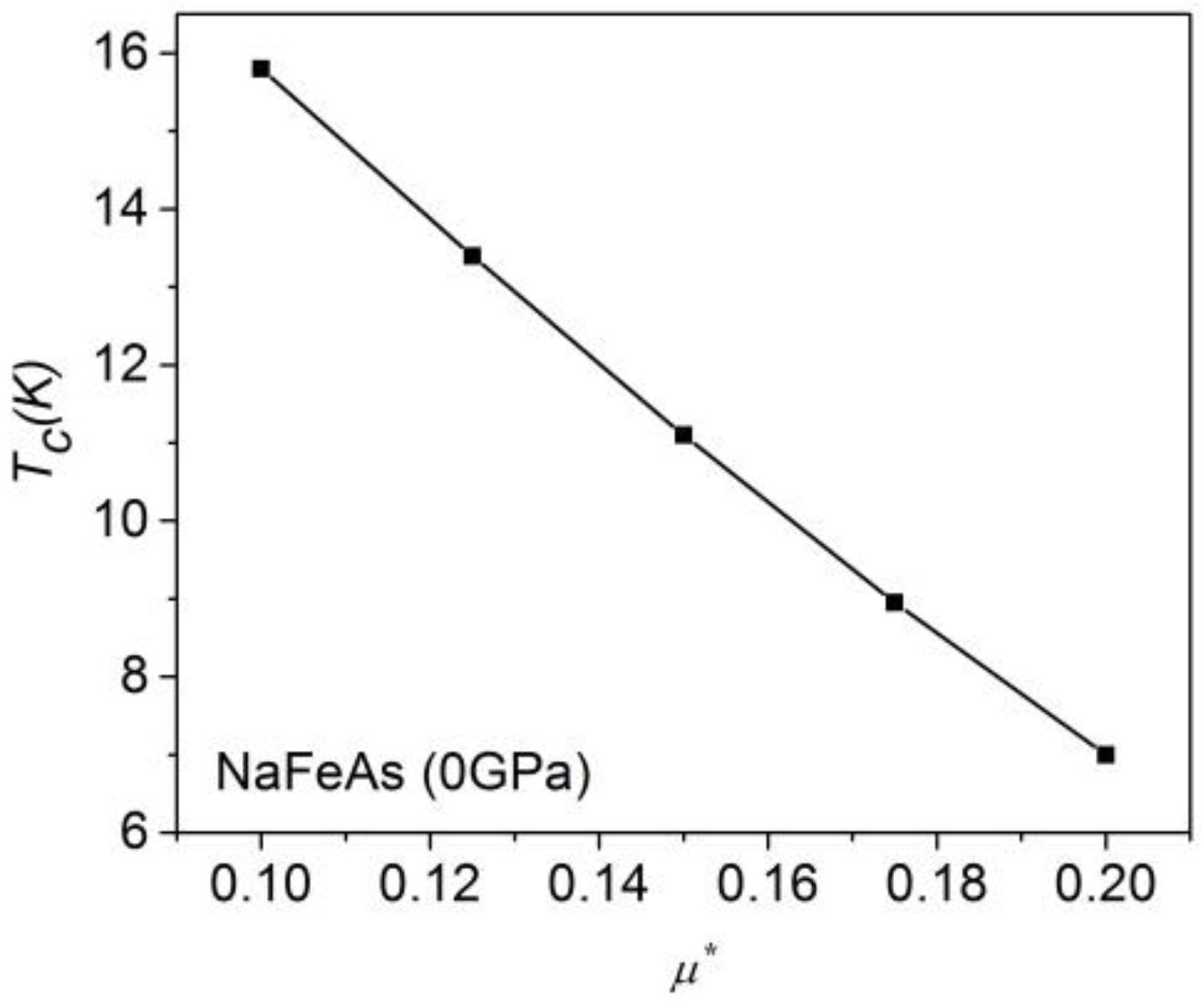Preliminary Tc Calculations for Iron-Based Superconductivity in NaFeAs, LiFeAs, FeSe and Nanostructured FeSe/SrTiO3 Superconductors
Abstract
1. Introduction
2. Computational Methods
3. Results



| P/GPa | a (Å) | c (Å) | FeAs Length (Å) | Rg | TDebye (K) |
|---|---|---|---|---|---|
| 0 | 3.929 | 6.890 | 2.400 | 1.00 | 385.0 |
| 1 | 3.914 | 6.833 | 2.388 | 1.00 | 385.5 |
| 2.0 | 3.900 | 6.777 | 2.376 | 1.00 | 386.0 |
| P/GPa | a (Å) | c (Å) | FeAs Length (Å) | Rg | TDebye (K) |
|---|---|---|---|---|---|
| 0 | 3.769 | 6.306 | 2.44 | 2.66 | 385.00 |
| 2.4 | 3.745 | 6.134 | 2.42 | 2.38 | 385.25 |
| 4.5 | 3.723 | 5.985 | 2.35 | 1.67 | 385.5 |
| 6.3 | 3.702 | 5.918 | 2.33 | 1.56 | 385.75 |
| P/GPa | a (Å) | c (Å) | FeSe Length (Å) | Rg | TDebye (K) |
|---|---|---|---|---|---|
| 0 | 3.767 | 5.485 | 2.390 | 3.04 | 240 |
| 0.7 | 3.746 | 5.269 | 2.388 | 2.05 | 256 |
| 2.0 | 3.715 | 5.171 | 2.384 | 4.92 | 274 |
| 3.1 | 3.698 | 5.114 | 2.382 | 2.50 | 290 |
4. Discussion
4.1. Are ARPES Data and the Coh Factors Important to IBSC?
4.2. Would the Errors in Tc Be Rescued by Nematicity and Spin–Orbital Coupling?
4.3. The Universal Theory of IBSC Remains an Open Question
5. Conclusions
Author Contributions
Funding
Institutional Review Board Statement
Informed Consent Statement
Data Availability Statement
Acknowledgments
Conflicts of Interest
References
- Bednorz, G.; Müller, K.A. Possible high Tc superconductivity in the Ba−La−Cu−O system. Z. Phys. B 1986, 64, 189–193. [Google Scholar] [CrossRef]
- Buchanan, M. Mind the pseudogap. Nature 2001, 409, 8–11. [Google Scholar] [CrossRef] [PubMed]
- Kamihara, Y.; Watanabe, T.; Hirano, M.; Hosono, H. Iron-Based Layered Superconductor La[O1−xFx]FeAs (x = 0.05−0.12) with Tc = 26 K. J. Am. Chem. Soc. 2008, 130, 3296–3297. [Google Scholar] [CrossRef] [PubMed]
- Norman, M.R. High-temperature superconductivity in the iron pnictides. Physics 2008, 1, 21. [Google Scholar] [CrossRef]
- Stewart, G.R. Heavy fermion systems. Rev. Mod. Phys. 1984, 56, 755787. [Google Scholar] [CrossRef]
- Lang, M.; Mueller, J. Organic superconductors. In The Physics of Superconductors; Bennemann, K.-H., Ketterson, J., Eds.; Springer: Berlin/Heidelberg, Germany, 2003; Volume 2. [Google Scholar]
- Fernandes, R.M.; Chubukov, A.V.; Schmalian, J. What drives nematic order in iron-based superconductors? Nat. Phys. 2014, 10, 97–104. [Google Scholar] [CrossRef]
- Grüner, G. The dynamics of charge-density waves. Rev. Mod. Phys. 1988, 60, 1129. [Google Scholar] [CrossRef]
- Chubukov, A.V.; Hirschfeld, P.J. Iron-based superconductors, seven years later. Phys. Today 2015, 68, 46–52. [Google Scholar] [CrossRef]
- Scalapino, D.J. Superconductivity and Spin Fluctuations. J. Low Temp. Phys. 1999, 117, 179–188. [Google Scholar] [CrossRef]
- Ginzburg, V.L.; Kirzhnits, D.A. (Eds.) High-Temperature Superconductivity; Consultance Bureau: New York, NY, USA, 1982. [Google Scholar]
- Hirschfeld, P.J.; Korshunov, M.M.; Mazin, I.I. Gap symmetry and structure of Fe-based superconductors. Rep. Prog. Phys. 2011, 74, 124508. [Google Scholar] [CrossRef]
- Little, W. Possibility of Synthesizing an Organic Superconductor. Phys. Rev. 1964, 134, A1416. [Google Scholar] [CrossRef]
- Ginzburg, V.L. On surface superconductivity. Phys. Lett. 1964, 13, 101–102. [Google Scholar] [CrossRef]
- Kontani, H.; Onari, S. Orbital-Fluctuation-Mediated Superconductivity in Iron Pnictides: Analysis of the Five-Orbital Hubbard-Holstein Model. Phys. Rev. Lett. 2010, 104, 157001. [Google Scholar] [CrossRef]
- Onari, S.; Kontani, H.; Sato, M. Structure of neutron-scattering peaks in both s++-wave and s±-wave states of an iron pnictide superconductor. Phys. Rev. B 2010, 81, 060504(R). [Google Scholar] [CrossRef]
- Saito, T.; Onari, S.; Kontani, H. Orbital fluctuation theory in iron pnictides: Effects of As-Fe-As bond angle, isotope substitution, and Z2-orbital pocket on superconductivity. Phys. Rev. B 2010, 82, 144510. [Google Scholar] [CrossRef]
- Jia, X.-W.; Liu, H.-Y.; Zhang, W.-T.; Zhao, L.; Meng, J.Q.; Liu, G.-D.; Dong, X.-L.; Wu, G.; Liu, R.-H.; Chen, X.-H.; et al. Common Features in Electronic Structure of the Oxypnictide Superconductor from Photoemission Spectroscopy. Chin. Phys. Lett. 2008, 25, 3765–3768. [Google Scholar]
- Zhang, C.; Liu, Z.; Chen, Z.; Xie, Y.; He, R.; Tang, S.; He, J.; Li, W.; Jia, T.; Rebec, S.N. Ubiquitous strong electron–phonon coupling at the interface of FeSe/SrTiO3. Nat. Commun. 2017, 8, 14468. [Google Scholar]
- Stockert, U.; Abdel-Hafiez, M.; Evtushinsky, D.V.; Zabolotnyy, V.B.; Wolter, A.U.B.; Wurmehl, S.; Morozov, I.; Klingeler, R.; Borisenko, S.V.; Büchner, B. Specific heat and angle-resolved photoemission spectroscopy study of the superconducting gaps in LiFeAs. Phys. Rev. B 2011, 83, 224512. [Google Scholar] [CrossRef]
- Coh, S.; Cohen, M.L.; Louie, S.G. Antiferromagnetism enables electron-phonon coupling in iron-based superconductors. Phys. Rev. B 2016, 94, 104505. [Google Scholar] [CrossRef]
- Li, B.; Xing, Z.W.; Huang, G.Q.; Liu, M. Magnetic-enhanced electron-phonon coupling and vacancy effect in “111”-type iron pnictides from first-principle calculations. J. Appl. Phys. 2012, 111, 033922. [Google Scholar] [CrossRef]
- Deng, S.; Köhler, J.; Simon, A. Electronic structure and lattice dynamics of NaFeAs. Phys. Rev. B 2009, 80, 214508. [Google Scholar] [CrossRef]
- Masaki, S.; Kotegawa, H.; Hara, Y.; Tou, H.; Murata, K.; Mizuguchi, Y.; Takano, Y. Precise Pressure Dependence of the Superconducting Transition Temperature of FeSe: Resistivity and 77Se-NMR Study. J. Phys. Soc. Jpn. 2009, 78, 063704. [Google Scholar] [CrossRef]
- Peng, R.; Shen, X.P.; Xie, X.; Xu, H.C.; Tan, S.Y.; Xia, M.; Zhang, T.; Cao, H.Y.; Gong, X.G.; Hu, J.P.; et al. Enhanced superconductivity and evidence for novel pairing in single-layer FeSe on SrTiO3 thin film under large tensile strain. Phys. Rev. Lett. 2014, 112, 107001. [Google Scholar] [CrossRef] [PubMed]
- Ge, J.; Liu, Z.; Liu, C.; Gao, C.; Qian, D.; Xue, Q.; Liu, Y.; Jia, J. Superconductivity above 100 K in single-layer FeSe films on doped SrTiO3. Nat. Mater. 2015, 14, 285–289. [Google Scholar] [CrossRef] [PubMed]
- Wu, H.-S.; Gu, Y.-M.; Mao, D.-Q. An Analytic Derivation for the McMillan Tc Formula (II)—Case of μ* ≠ 0. Acta Phys. Sin. 1981, 30, 1137–1140. [Google Scholar]
- Zhang, A.-M.; Zhang, Q.-M. Electron-phonon coupling in cuprate and iron-based superconductors revealed by Raman scattering. Chin. Phys. B 2013, 22, 087103. [Google Scholar] [CrossRef]
- Wang, Z.; Liu, C.; Liu, Y.; Wang, J. High-temperature superconductivity in one-unit-cell FeSe films. J. Phys. Condens. Matter 2017, 29, 153001. [Google Scholar] [CrossRef]
- Bang, Y. Phonon Boost Effect on the S±-wave Superconductor with Incipient Band. Sci. Rep. 2019, 9, 3907. [Google Scholar] [CrossRef]
- Zhang, S.; Guan, J.; Wang, Y.; Berlijn, T.; Johnston, S.; Jia, X.; Liu, B.; Zhu, Q.; An, Q.; Xue, S.; et al. Lattice dynamics of ultrathin FeSe films on SrTiO3. Phys. Rev. B 2018, 97, 035408. [Google Scholar] [CrossRef]
- Milman, V.; Refson, K.; Clark, S.J.; Pickard, C.J.; Yates, J.R.; Gao, S.-P.; Hasnip, P.J.; Probert, M.I.J.; Perlov, A.; Segall, M.D. Electron and vibrational spectroscopies using DFT, plane waves and pseudopotentials: CASTEP implementation. J. Mol. Struct. THEOCHEM 2010, 954, 22–35. [Google Scholar] [CrossRef]
- Perdew, J.P.; Chevary, J.A.; Vosko, S.H.; Jackson, K.A.; Pederson, M.R.; Singh, D.J.; Fiolhais, C. Atoms, molecules, solids, and surfaces: Applications of the generalized gradient approximation for exchange and correlation. Phys. Rev. B 1992, 46, 6671. [Google Scholar] [CrossRef]
- Becke, A.D. Density-functional exchange-energy approximation with correct asymptotic behavior. Phys. Rev. A 1988, 38, 3098. [Google Scholar] [CrossRef]
- Zhang, M.; He, L.-M.; Zhao, L.-X.; Feng, X.-J.; Cao, W.; Luo, Y.-H. A density functional theory study of the Au7Hn (n = 1–10) clusters. J. Mol. Struct. THEOCHEM 2009, 911, 65–69. [Google Scholar] [CrossRef]
- Hu, Z.; Xu, W.; Chen, C.; Wen, Y.; Liu, L. First-Principles Calculations of the Structure Stability and Mechanical Properties of LiFeAs and NaFeAs under Pressure. Adv. Mat. Sci. Eng. 2018, 2018, 3219685. [Google Scholar] [CrossRef]
- Bendele, M.; Marini, C.; Joseph, B.; Simonelli, L.; Dore, P.; Pascarelli, S.; Chikovani, M.; Pomjakushina, E.; Conder, K.; Saini, N.L.; et al. Dispersive x-ray absorption studies at the Fe K-edge on the iron chalcogenide superconductor FeSe under pressure. J. Phys. Condens. Matter 2013, 25, 425704. [Google Scholar] [CrossRef]
- Jang, J.K.; Rhee, J.Y. Magnetic States of Iron-based Superconducting Compounds: A Comparative Study with Fe3Al Alloy. J. Korean Phys. Soc. 2015, 66, 646–650. [Google Scholar] [CrossRef]
- Coh, S.; Cohen, M.L.; Louie, S.G. Large electron–phonon interactions from FeSe phonons in a monolayer. New J. Phys. 2015, 17, 073027. [Google Scholar] [CrossRef]
- McMillian, W.L. Transition Temperature of Strong-Coupled Superconductors. Phys. Rev. 1968, 167, 331. [Google Scholar] [CrossRef]
- Weng, K.-C.; Hu, C.D. The p-wave superconductivity in the presence of Rashba interaction in 2DEG. Sci. Rep. 2016, 6, 29919. [Google Scholar] [CrossRef]
- König, E.J.; Coleman, P. The Coulomb problem in iron based superconductors. Phys. Rev. B 2019, 99, 144522. [Google Scholar] [CrossRef]
- Yi, M.; Lu, D.H.; Moore, R.G.; Kihou, K.; Lee, C.-H.; Iyo, A.; Eisaki, H.; Yoshida, T.; Fujimori, A.; Shen, Z.-X. Electronic reconstruction through the structural and magnetic transitions in detwinned NaFeAs. New J. Phys. 2012, 14, 073019. [Google Scholar] [CrossRef]
- Wang, A.F.; Xiang, Z.J.; Ying, J.J.; Yan, Y.J.; Cheng, P.; Ye, G.J.; Luo, X.G.; Chen, X.H. Pressure effects on the superconducting properties of single-crystalline Co doped NaFeAs. New J. Phys. 2012, 14, 113043. [Google Scholar] [CrossRef]
- Jishi, R.A.; Scalapino, D. Contribution of the electron-phonon coupling to the pairing interaction in LiFeAs. Phys. Rev. B 2013, 88, 184505. [Google Scholar] [CrossRef]
- Liu, L.; Xu, G.; Wang, A.; Wu, X.; Wang, R. First-principles investigations on structure stability, elastic properties, anisotropy and Debye temperature of tetragonal LiFeAs and NaFeAs under pressure. J. Phys. Chem. Solids 2017, 104, 243–251. [Google Scholar] [CrossRef]
- Zhang, S.J.; Wang, X.C.; Sammynaiken, R.; Tse, J.S.; Yang, L.X.; Li, Z.; Liu, Q.Q.; Desgreniers, S.; Yao, Y.; Liu, H.Z.; et al. Effect of pressure on the iron arsenide superconductor LixFeAs (x = 0.8, 1.0, 1.1). Phys. Rev. B 2009, 80, 014506. [Google Scholar] [CrossRef]
- Medvedev, S.; McQueen, T.M.; Troyan, I.A.; Palasyuk, T.; Eremets, M.I.; Cava, R.J.; Naghavi, S.; Casper, F.; Ksenofontov, V.; Wortmann, G.; et al. Electronic and magnetic phase diagram of β-Fe1.01Se with superconductivity at 36.7 K under pressure. Nat. Mater. 2009, 8, 630–633. [Google Scholar] [CrossRef]
- Koufos, A.P.; Papaconstantopoulos, D.A. A first-principles study of the electronic structure of Iron-Selenium; Implications for electron-phonon superconductivity. Phys. Rev. B 2014, 89, 035150. [Google Scholar] [CrossRef]
- Wang, Y.; Ding, Y.; Ni, J. First-principles study of pressure effects on CaFe2As2 and BaFe2As2. Solid State Commun. 2009, 149, 2125–2129. [Google Scholar] [CrossRef]
- Paglione, J.P.; Greene, R.L. High-temperature superconductivity in iron-based materials. Nat. Phys. 2010, 6, 645–658. [Google Scholar] [CrossRef]
- Fujitsu, S.; Matsuishi, S.; Hosono, H. Iron based superconductors processing and properties. Int. Mater. Rev. 2012, 57, 311–327. [Google Scholar] [CrossRef]
- Shukor, R.A. Calculated Sound Velocity Change in LaFeAsO0.89F0.11 at the Superconducting Transition. J. Supercond. Nov. Magn. 2010, 23, 1229–1230. [Google Scholar] [CrossRef]
- Wen, Y.; Wu, D.; Cao, R.; Liu, L.; Song, L. The Third-Order Elastic Moduli and Debye Temperature of SrFe2As2 and BaFe2As2: A First-Principles Study. J. Supercond. Nov. Magn. 2017, 30, 1749–1756. [Google Scholar] [CrossRef]
- Kang, J.; Fernandes, R.M.; Chubukov, A. Superconductivity in FeSe: The Role of Nematic Order. Phys. Rev. Lett. 2018, 120, 267001. [Google Scholar] [CrossRef]
- Ptok, A.; Rodríguez, K.; Kapcia, K.J. Superconducting monolayer deposited on substrate: Effects of the spin-orbit coupling induced by proximity effects. Phys. Rev. Mater. 2018, 2, 024801. [Google Scholar] [CrossRef]
- Hutchinson, J.; Hirsch, J.E.; Marsiglio, F. Enhancement of superconducting Tc due to the spin-orbit interaction. Phys. Rev. B 2018, 97, 184513. [Google Scholar] [CrossRef]
- Yin, Z.P.; Kutepov, A.; Kotliar, G. Correlation-Enhanced Electron-Phonon Coupling: Applications of GW and Screened Hybrid Functional to Bismuthates, Chloronitrides, and Other High-Tc Superconductors. Phys. Rev. X 2013, 3, 021011. [Google Scholar] [CrossRef]


| FeSe | Experimental Tc | Theoretical Tc (A) | Theoretical Tc (B) |
|---|---|---|---|
| 0 GPa | 11 K | 13 K | 12 K |
| 0.7 GPa | 16 K | 4 K | 15 K |
| 2 GPa | 20 K | 3 K | 22 K |
| FeSe | Experimental Tc | Theoretical Tc (Without Rg Term) | Theoretical Tc (With Rg Term) |
|---|---|---|---|
| 0 GPa | 11 K | 3 K | 12 K |
| 0.7 GPa | 16 K | 6 K | 15 K |
| 2 GPa | 20 K | 8 K | 22 K |
| LiFeAs | Experimental Tc | Theoretical Tc (Without Rg Term) | Theoretical Tc(With Rg term) |
| 0 GPa | 19 K | 2 K | 23 K |
| 2.4 GPa | 15 K | 7 K | 17 K |
| 4.5 GPa | 13 K | 8 K | 9 K |
| 6.3 GPa | 10 K | 4 K | 7 K |
| a (Å) | b (Å) | c (Å) | D (Å) | λFermi | Rg | Debye (K) |
|---|---|---|---|---|---|---|
| 3.8197 | 3.8698 | 5.9540 | 52.484 Å | 1.6 | 1.96 | 1159 |
Disclaimer/Publisher’s Note: The statements, opinions and data contained in all publications are solely those of the individual author(s) and contributor(s) and not of MDPI and/or the editor(s). MDPI and/or the editor(s) disclaim responsibility for any injury to people or property resulting from any ideas, methods, instructions or products referred to in the content. |
© 2023 by the authors. Licensee MDPI, Basel, Switzerland. This article is an open access article distributed under the terms and conditions of the Creative Commons Attribution (CC BY) license (https://creativecommons.org/licenses/by/4.0/).
Share and Cite
Wong, C.H.; Lortz, R. Preliminary Tc Calculations for Iron-Based Superconductivity in NaFeAs, LiFeAs, FeSe and Nanostructured FeSe/SrTiO3 Superconductors. Materials 2023, 16, 4674. https://doi.org/10.3390/ma16134674
Wong CH, Lortz R. Preliminary Tc Calculations for Iron-Based Superconductivity in NaFeAs, LiFeAs, FeSe and Nanostructured FeSe/SrTiO3 Superconductors. Materials. 2023; 16(13):4674. https://doi.org/10.3390/ma16134674
Chicago/Turabian StyleWong, Chi Ho, and Rolf Lortz. 2023. "Preliminary Tc Calculations for Iron-Based Superconductivity in NaFeAs, LiFeAs, FeSe and Nanostructured FeSe/SrTiO3 Superconductors" Materials 16, no. 13: 4674. https://doi.org/10.3390/ma16134674
APA StyleWong, C. H., & Lortz, R. (2023). Preliminary Tc Calculations for Iron-Based Superconductivity in NaFeAs, LiFeAs, FeSe and Nanostructured FeSe/SrTiO3 Superconductors. Materials, 16(13), 4674. https://doi.org/10.3390/ma16134674





